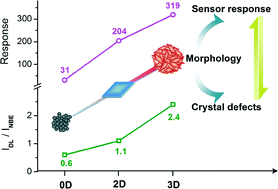As the number of cars continues to increase, the problem of hazardous exhaust fumes such as nitrogen dioxide (NO2) becomes more pressing. New gas sensors are required to determine the quantities of these gases quickly and accurately. These are often made of metal oxide semiconductors, including tungsten trioxide (WO3), which are easily fabricated, low cost materials. Nano-sized structures typically possess better gas adsorption properties than the bulk material due to favourable surface effects but particles of different shapes (morphologies) could also have different gas-sensing properties.
A new paper presents a method of producing three different morphologies of WO3 nanostructures and studies their gas-sensing abilities. In the simple hydrothermal synthesis, control of morphology is achieved using different amounts of citric acid, thereby changing the number of available carboxyl-groups. This produces nanoparticles (0D), nanoplates (2D) and hierarchical microspheres (3D). Among these 3 morphologies, the hierarchical structures are found to show the best gas-sensing properties towards NO2 (see diagram below), with a high sensitivity, a fast response time and operating at a relatively low temperature (200oC).
Authors conclude that this is due to an increased number of defects present in the structure which increases the number of gas adsorption sites on the surface, while their internal structure accelerates transport of the gas molecules to the sensing sites.
For more information, see the full article at:
Shouli Bai, Kewei Zhang, Xin Shu, Song Chen, Ruixian Luo, Dianqing Li and Aifan Chen
CrystEngComm, 2014, Advance Article
DOI: 10.1039/C4CE01167H
_____________________________________________________________________________________________________
 Gwenda Kyd has a PhD in metallocarborane chemistry from the University of Edinburgh. Other research work includes the spectroscopic study of the structure of glasses and organometallic electron-transfer reactions and the preparation of new inorganic phosphors. She has recently published a book on chemicals from plants.
Gwenda Kyd has a PhD in metallocarborane chemistry from the University of Edinburgh. Other research work includes the spectroscopic study of the structure of glasses and organometallic electron-transfer reactions and the preparation of new inorganic phosphors. She has recently published a book on chemicals from plants.











